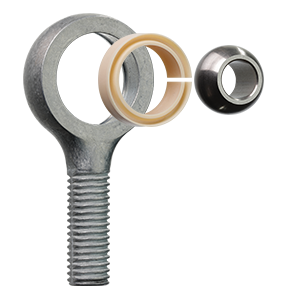Is it ok if the spherical ball rotates inside the spherical bearing housing?
Peter Hughes | 6. November 2020
This is a question we hear a lot when customers ask about igubal® spherical bearings. Customers often wonder if this is acceptable and if it has any effect on their application.
I’d love to give here a short answer like “Yes” or “No”. But in fact, it depends on the type of igubal bearing and the materials used in the ball and the housing, and of course it also depends on the application itself. Here I will distinguish between 3 different cases (in all cases the application relates to a metal shaft):
The standard solution (polymer ball in polymer housing):
For most of our igubal bearings, we use an igumid G housing and a polymer ball made of iglidur W300 or other tribo-polymers. Here the following rule applies: The shaft moves inside the ball, and the ball only does a swiveling movement inside the housing (to avoid misalignment errors or to fulfill a pivoting movement needed in the application).
It doesn’t matter if the movement of the shaft inside the ball is rotating, swiveling or even a linear motion.
The reason for this arrangement is very simple: You will always achieve the best results with a combination of a plastic bearing and a metal shaft in terms of wear and friction (compared with metal/metal or plastic/plastic).
There is only one exception in the catalog, where it is acceptable for the plastic ball to rotate inside the plastic housing: the ESQM pillow block bearing. This is our solution for big square shafts, mostly used in solar applications. In this kind of application, the bearings must withstand a high load – but just a very slow speed – following the sun’s path. You will therefore never encounter high temperatures that are caused by friction, and the wear on the parts is limited, despite the combination of plastic housing and plastic ball. Not to mention the fact that it would be extremely difficult to rotate a square shaft in a square insert 😉.

Exchangeable balls (plastic) in metal housings
When it comes to our interchangeable balls in metal housing, you might think that it this doesn’t matter if the (polymer) ball rotates in the metal housing or if the metal shaft rotates in the polymer ball: in both cases metal is in contact with plastic, so there should be no problems with friction or wear. This is, however, not the case. On the one hand, it makes a difference whether the bearing is subjected to linear or rotary movement. On the other hand, the tolerances and the surface in the inside of the metal housing are not designed for rotation, even when used with a high-tech polymer ball.

So the standard igubal rule applies here as well: shafts rotate inside the ball, while the ball only pivots inside the housing.
igubal rod ends 2.0 (metal housing, metal ball)
We recently launched the new igubal 2.0 rod ends: a metal housing and a metal ball – not a good combination for wear resistance, especially without any lubrication. But in between there is an insert made of iglidur® polymers, such as iglidur J. In this case, the shaft is fixed inside the metal ball and the metallic ball rotates (and does the pivoting movement) inside the polymer insert.

As a conclusion we can say that the metallic shaft should always rotate inside the plastic ball, except when there is a square shaft or a metal ball.
Do you have a question relating to igubal self-aligning bearings? Feel free to contact us. We look forward to hearing from you.
